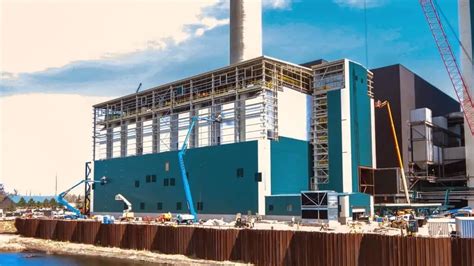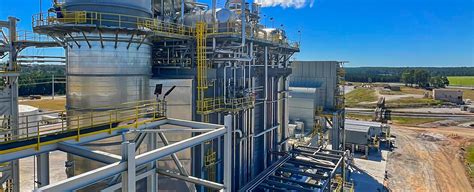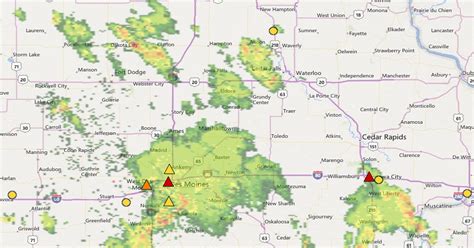The Boswell Energy Center, located in Cohasset, Minnesota, is a vital component of the state's energy infrastructure. As a major power plant, it plays a crucial role in meeting the energy demands of the region. With a rich history dating back to the 1950s, the Boswell Energy Center has undergone significant transformations over the years to ensure its continued relevance and efficiency in the ever-evolving energy landscape.
Originally constructed in 1958, the Boswell Energy Center was designed to provide electricity to the surrounding areas, primarily serving the needs of the local community. The plant's initial capacity was relatively modest, with a single unit generating approximately 65 megawatts (MW) of electricity. However, as the region's energy demands grew, so did the plant's capacity. Over the years, additional units were added, increasing the plant's total generating capacity to over 1,100 MW. This expansion not only enhanced the plant's ability to meet local energy needs but also positioned it as a key player in the regional energy market.
Key Points
- The Boswell Energy Center is a major power plant located in Cohasset, Minnesota, with a total generating capacity of over 1,100 MW.
- The plant has undergone significant transformations since its construction in 1958, with a focus on increasing efficiency and reducing environmental impact.
- Boswell Energy Center is owned and operated by Minnesota Power, a subsidiary of ALLETE, Inc.
- The plant's energy output is primarily generated from coal, with a smaller portion coming from natural gas and biomass.
- Minnesota Power has committed to reducing the plant's carbon emissions by 80% by 2035, with plans to achieve this goal through a combination of efficiency improvements and the integration of renewable energy sources.
Energy Generation and Capacity

The Boswell Energy Center’s energy generation is primarily based on coal, with the plant’s four units burning a total of approximately 4 million tons of coal per year. However, in recent years, Minnesota Power has taken steps to diversify the plant’s energy mix, incorporating natural gas and biomass into its generation portfolio. This strategic shift not only reduces the plant’s reliance on a single fuel source but also helps to decrease its environmental footprint.
Unit 4, the plant's largest and most efficient unit, has a generating capacity of 355 MW and is equipped with advanced pollution control technology. This unit is designed to minimize emissions while maximizing energy output, making it an integral part of the plant's operations. In addition to Unit 4, the plant also features three smaller units, each with a generating capacity ranging from 65 to 165 MW. These units provide flexibility and redundancy, ensuring that the plant can continue to operate efficiently even during periods of maintenance or unexpected outages.
Environmental Considerations and Sustainability Initiatives
As the energy sector continues to evolve, environmental considerations and sustainability initiatives have become increasingly important. The Boswell Energy Center, like many other power plants, faces the challenge of balancing energy production with environmental responsibility. In response to these concerns, Minnesota Power has implemented various measures aimed at reducing the plant’s environmental impact.
One of the key initiatives is the installation of advanced pollution control technology, including selective catalytic reduction (SCR) systems and electrostatic precipitators. These systems help to minimize emissions of nitrogen oxides, sulfur dioxide, and particulate matter, ensuring that the plant operates within strict environmental guidelines. Furthermore, Minnesota Power has committed to reducing the plant's carbon emissions by 80% by 2035, with plans to achieve this goal through a combination of efficiency improvements, fuel switching, and the integration of renewable energy sources.
| Unit Number | Generating Capacity (MW) | Fuel Source |
|---|---|---|
| 1 | 65 | Coal |
| 2 | 165 | Coal |
| 3 | 235 | Coal/Natural Gas |
| 4 | 355 | Coal |

Ownership and Operation

The Boswell Energy Center is owned and operated by Minnesota Power, a subsidiary of ALLETE, Inc. As a leading energy provider in the region, Minnesota Power is committed to delivering safe, reliable, and affordable energy to its customers. The company’s dedication to environmental stewardship and community engagement is reflected in its operational practices and sustainability initiatives.
Under Minnesota Power's ownership, the Boswell Energy Center has undergone significant upgrades and improvements, enhancing its efficiency and reducing its environmental impact. The company's commitment to transparency and accountability is evident in its regular reporting on the plant's operations, emissions, and sustainability initiatives. This open communication helps to foster trust and cooperation between the company, local communities, and regulatory bodies.
Future Outlook and Challenges
As the energy sector continues to evolve, the Boswell Energy Center faces both opportunities and challenges. The plant’s ability to adapt to changing energy demands, environmental regulations, and technological advancements will be crucial to its long-term viability. Minnesota Power’s commitment to reducing the plant’s carbon emissions and exploring alternative fuel sources positions the company for success in a rapidly changing energy landscape.
However, the path forward is not without challenges. The integration of renewable energy sources, such as wind and solar power, into the plant's operations will require significant investment and infrastructure upgrades. Additionally, the plant must navigate complex regulatory frameworks and ensure compliance with evolving environmental standards. By leveraging its expertise, investing in innovative technologies, and engaging with stakeholders, Minnesota Power is well-equipped to address these challenges and ensure the Boswell Energy Center remains a vital component of the regional energy infrastructure.
What is the total generating capacity of the Boswell Energy Center?
+The Boswell Energy Center has a total generating capacity of over 1,100 MW.
What fuel sources does the Boswell Energy Center use?
+The Boswell Energy Center primarily uses coal, with a smaller portion of its energy output coming from natural gas and biomass.
What are Minnesota Power’s plans for reducing the Boswell Energy Center’s carbon emissions?
+Minnesota Power has committed to reducing the Boswell Energy Center’s carbon emissions by 80% by 2035, with plans to achieve this goal through a combination of efficiency improvements, fuel switching, and the integration of renewable energy sources.



